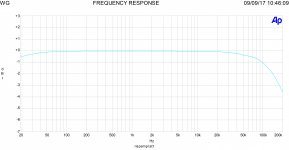Btw, the EF86's main feature for to achieve very low hum despite AC heating is it's bifilarly wound heater, same as in all European ECC83's and in the Statesian 7025.
Best regards!
Best regards!
For me, the challenge was to design a circuit without semiconductors and I didn't fancy using mercury vapor rectifiers or accumulators, so I more or less automatically ended up with AC heater supply. It worked just fine, although it did limit the choices for what tubes and topologies to use.
RIAA conformity, as mentioned in post #69:
+0.1 dB/-0.2 dB at 1 Mohm load, +0 dB/-0.3 dB at 10 kohm load, 20 Hz to 20 kHz, measured values of the worst of two channels
Distortion at 1 V RMS output level:
100 Hz, 47.6 kohm load: << 0.16 %
400 Hz, 47.6 kohm load: 0.045 %
400 Hz, 8.26 kohm load: 0.062 %
1 kHz, 8.26 kohm load: 0.05 %
10 kHz, 8.26 kohm load: 0.12 %
The gain at 1 kHz is about 42 dB.
RIAA conformity, as mentioned in post #69:
+0.1 dB/-0.2 dB at 1 Mohm load, +0 dB/-0.3 dB at 10 kohm load, 20 Hz to 20 kHz, measured values of the worst of two channels
Distortion at 1 V RMS output level:
100 Hz, 47.6 kohm load: << 0.16 %
400 Hz, 47.6 kohm load: 0.045 %
400 Hz, 8.26 kohm load: 0.062 %
1 kHz, 8.26 kohm load: 0.05 %
10 kHz, 8.26 kohm load: 0.12 %
The gain at 1 kHz is about 42 dB.
Btw, the EF86's main feature for to achieve very low hum despite AC heating is it's bifilarly wound heater, same as in all European ECC83's and in the Statesian 7025.
Best regards!
An EF86 has a far lower heater to grid capacitance spec than an ECC83, though.
What is the source/evidence for all European ECC83's having bifilar heaters?
In this 1966 article in Wireless World (see page 240) the author writes that the ECC83 has a normal heater, as opposed to the bifilar type of the EF86: http://www.keith-snook.info/wireless-world-magazine/Wireless-World-1966/A.F.%20Amplification%20with%20the%20Cascode.pdf
On this forum DF96 wrote that the genuine ECC83 did have a helical heater like the EF86 but that's about the only other clue I can find for all European ECC83's having a bifilar heater: https://www.diyaudio.com/forums/instruments-and-amps/249553-tube-heater-wiring-options-3.html#post3973618
In this 1966 article in Wireless World (see page 240) the author writes that the ECC83 has a normal heater, as opposed to the bifilar type of the EF86: http://www.keith-snook.info/wireless-world-magazine/Wireless-World-1966/A.F.%20Amplification%20with%20the%20Cascode.pdf
On this forum DF96 wrote that the genuine ECC83 did have a helical heater like the EF86 but that's about the only other clue I can find for all European ECC83's having a bifilar heater: https://www.diyaudio.com/forums/instruments-and-amps/249553-tube-heater-wiring-options-3.html#post3973618
Last edited:
Even less Cga can be seen in the PC88, which is the PC86's succedessor in the 1st stage of European UHF frontends.
Thanks for the info, but when I look in the Philips data sheet for PC88 I see a Cga specification of 1.2pF (without external screening). For comparison, PC97 Cga is stated to be 0.52pF.
PC88 data sheet:
https://frank.pocnet.net/sheets/030/p/PC88.pdf
The PC86 and PC88 were designed for use in grounded grid circuits. Because of that Cag is less important than in triodes like the PC97 and the PC900, which were designed for use in common cathode circuits.
The PC86 and PC88 were designed for use in grounded grid circuits. Because of that Cag is less important than in triodes like the PC97 and the PC900, which were designed for use in common cathode circuits.
The first stage of a phono preamp is just about always going to use a triode (or a pentode) in some form of a common cathode arrangement. If a triode, and if the preamp is to be used with a MM cartridge, then input capacitance will be an important characteristic. That is why the PC97 and PC900 look attractive, since they both have Cga of </= 0.52pF.
If one assumes an additional 1pF stray capacitance, then Cga = 1.5pF, Cgk = 4pF, and gain = 50X, then
4pF + 1.5pF(50 + 1) = 79pF
If using a PC88 instead, Cga = 1.2pF, and adding 1pF for strays, and gain = ca. 45X,
4pF + 2.2pF(45 + 1) = 105pF
That's pretty good, almost exactly the same as a 6DJ8/ECC88 would give you, but with approximately double the gain.
So yes, PC88 looks like a contender too.
I stumbled onto this old thread and just wanted to wrap things up. A friend and I eventually co-designed/built a phono preamp with a 'hybrid cascode' first stage using an LSK170 in the bottom and any old medium-mu triode on top (could have been 12AU7 but I used 6N6P because I have a bunch of them and heater power wasn't a big deal). The RIAA filter network is the usual passive type. The output stage is a 6DJ8 mu-follower with DN2540 as the plate load. It plays nicely with my Audio Technica MM cartridges, which I think supports the idea that these carts do require low input C. I'm happy with the setup.
- Home
- Amplifiers
- Tubes / Valves
- EF184 in triode for phono stage input?
